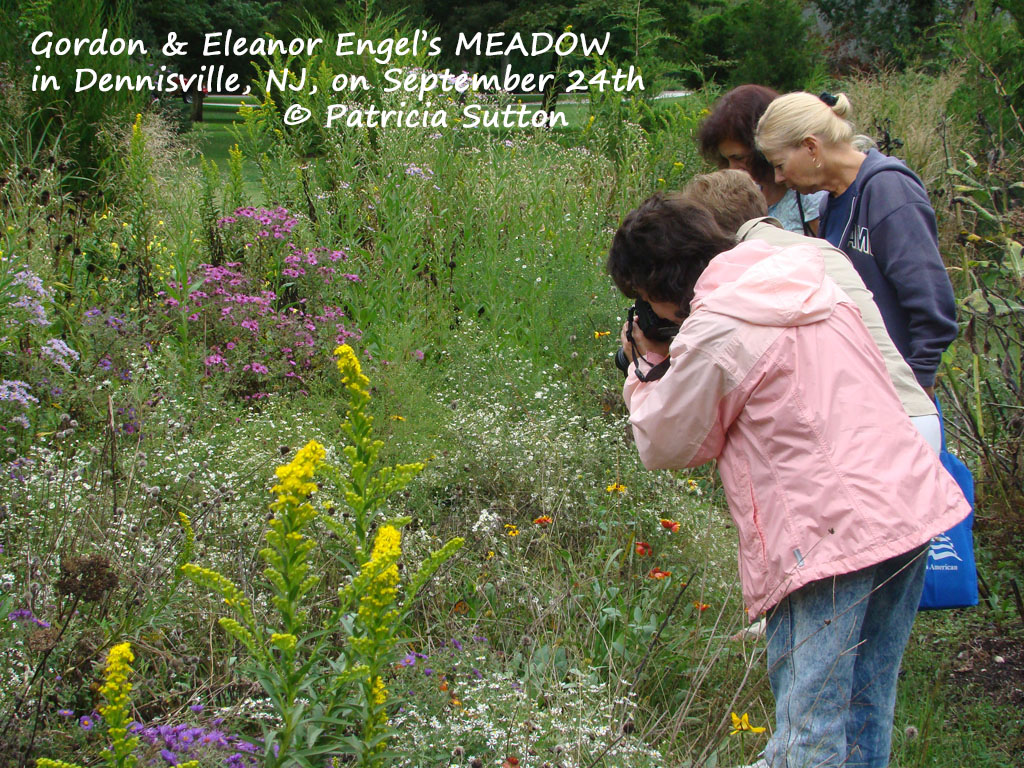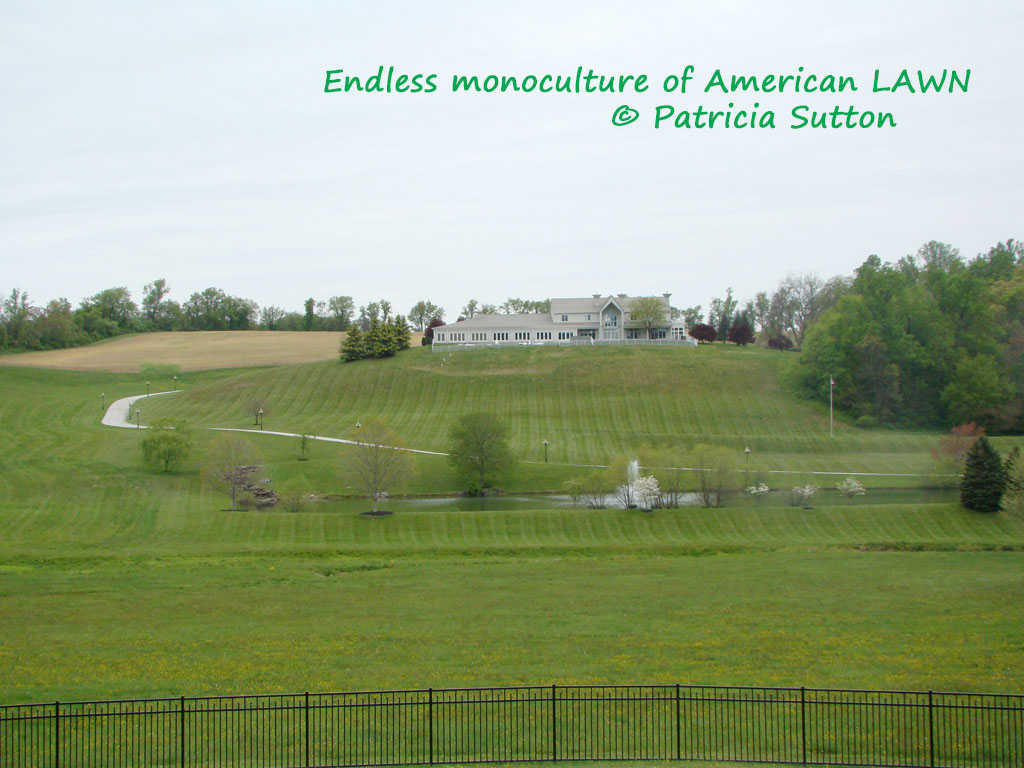 Americans have a love affair with the American Lawn! This unnatural habitat is labor intensive to maintain, hard on the environment (i.e. isn’t green in the true sense of the word), and it benefits little.
Americans have a love affair with the American Lawn! This unnatural habitat is labor intensive to maintain, hard on the environment (i.e. isn’t green in the true sense of the word), and it benefits little.
 Consider creating a meadow instead! But, what is a meadow? It may be easier to define what a meadow is NOT: it’s not sterile, it’s not a monoculture; it’s not “needy” of fertilizer, water, weekly mowings, and other pamperings, all of which contribute to greenhouse gasses.
Consider creating a meadow instead! But, what is a meadow? It may be easier to define what a meadow is NOT: it’s not sterile, it’s not a monoculture; it’s not “needy” of fertilizer, water, weekly mowings, and other pamperings, all of which contribute to greenhouse gasses.
A meadow is a mixture of grasses and wildflowers growing in a sunny, open area. A meadow is a riot of color. It’s diverse, full of many different plants, with as many as 7 different plants (or more) in a 1 foot square – in other words much more intense than your perennial garden. Meadow plants require no water (as opposed to lawns) – except, of course, when seeds, plugs, or plants are first planted.
 Meadow plants prefer and can thrive in sterile soils. Meadows are nonpolluting; they do not need weekly chemicals of fertilizers and herbicides. And meadows require no weekly mowing, as opposed to lawns.
Meadow plants prefer and can thrive in sterile soils. Meadows are nonpolluting; they do not need weekly chemicals of fertilizers and herbicides. And meadows require no weekly mowing, as opposed to lawns.
Most meadows result from neglect – a time of transition – when a farmer no longer farms, or a lawn is no longer cut, or cattle are no longer grazed there. Meadows are a transitional stage that eventually will be invaded and replaced by shrubs and trees, if not maintained or managed. To keep a meadow a meadow, it does need to be mowed once a year. And the best time to mow your meadow, if you are also trying to support and benefit wildlife, is in late February or early March. This annual mowing prevents tree and shrub seedings (planted by birds or windblown) from surviving and thriving and eventually turning your meadow into a forest.
So, what do you say? Are you ready to LOSE THE LAWN (or part of your lawn) & CREATE A WILDFLOWER MEADOW INSTEAD? If so, you’ll learn a whole lot more by reading my handouts on this topic, found below (CLICK on underlined text to download Pat’s pdf document).
Pat Sutton’s MEADOW Handout (part 1: pages 1-4) — Updated May 2024
Pat Sutton’s MEADOW Handout (part 2: pages 5-6)
Of course you want to select native plants for your meadow, so be sure to also read my post (and associated handout) on GARDENING FOR POLLINATORS, which includes tons more helpful information and resources!

I live in the South Georgia, so some of the native grasses and plants will be different. I am searching for a local native plant nursery.
Hi Donna, May I assume you mean southern Georgia in the US (and not South Georgia Island)? If so, try googling native plant nurseries Georgia. I did so and immediately found several links that look reputable: https://georgiawildlife.com/sites/default/files/wrd/pdf/contests/2019NativePlantNurseriesList_SBG.pdf
https://gnps.org/georgias-native-plants/sources-native-plants/
Native Plant Societies are always good places to start and you are fortunate that Georgia has a Native Plant Society.
Have fun with your new natives!
Pat
I lived in Atlanta and we regularly bought plants from Beech Hollow Nursery. They’re up near Athens and have a great selection of native plants.
Hi Javier, thanks so much for sharing a nursery near you that offers a “great selection of native plants.” Pat
Hi Pat,
We’re so grateful for your site and all the work you’ve done. When planting natives, do you recommend adding a compost/food to the soil at the beginning or periodically? We are in Cape May County too near the ocean and we tried beach grass in the yard but it died after a year–the seller later said we should have fed it. Thought that wasn’t necessary with true native plants?
Thank you so much!
Hi Erika,
With my own garden I nourish it with natural mulches that break down into soil over the years and naturally help enrich the soil: Salt Hay, Pine Needles (that fall from White Pines overhead), fallen leaves, and in the early years I used grass clippings (from someone who mowed lawns and would bring me a truck load each week — it was incredible mulch for my perennial garden and became rich soil, but was labor intensive and meant dropping everything when a load was dropped off . . . or it would get stinky). I’ve never planted Beach Grass, so have no idea about nourishing it. With last year’s drought, just about anything that was planted would have needed watering (including newly planted native plants). Native plants, when newly planted, definitely need some tender loving care the 1st year until their roots are established (this may mean regular watering, especially if we’re experiencing a drought, and good mulching so that the soil around the new roots does not become a brick). But, NO, I’ve never “FED” my native plantings, nor felt the need to. Though the natural mulches I use, naturally “feed” the soil and the plants in the garden. Hope this helps! Pat
Dutch white clover
Clearly not a nj native.
Also, clearly beneficial to a vast array of wildlife as well as to soil quality.
I feel morally caught in the snide.
Wisdom, please?
Hi Robert, Thanks for chiming in regarding clover in lawns. For years we’ve seeded our minimal lawn areas with clover. It not only provides important nectar (especially the way we mow, only when it grows exceptionally tall . . . in other words only when it needs it, not every week), it also (being a legume) fixes nitrogen, which means that clover injects nitrogen into the soil as it grows and spreads. So, it is a natural fertilizer! Landscapers who plant solely grass seed then make the homeowner dependent on fertilizer to keep the grass happy.